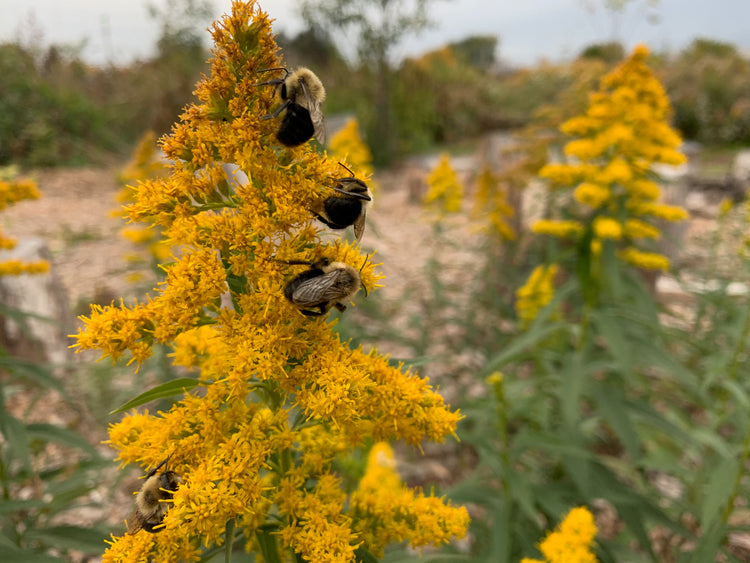Learning from Indigenous Knowledge, our approach to stewardship rests on a foundation of relationality. We ask ourselves "How are the relations of this place doing?" Our role, as humans, within the little forest community is to help maintain an ecological balance.

Watering the forest
We plant in fall when rain is frequent to give time for the trees to settle in, begin establishing their root systems, and begin establishing relationships with a mycorrhizal network.
We’ll water infrequently, only as needed. Our most important consideration when determining when to water is to ensure healthy soil microbiology and good root development. Droughts kill many soil microorganisms. If there’s an extended drought (over 5 weeks of no rain), we’ll water the entire forest floor with 2.5 cm (1 inch) of water depending on soil conditions. (Sandy soils may need watering sooner, and more often whereas heavy clay soils may retain their moisture longer and when watering best to do it less often but more deeply).
Keeping an eye out for pests
Forests are balanced ecosystems, containing many types of insects and other creatures vital for maintaining a healthy ecosystem. Caterpillars, for example, are vital food sources for birds especially when they’re rearing their young.
We subscribe to a holistic approach, understanding that pests are a symptom, not a problem— a sign that the tree or forest isn’t getting what it needs to stay healthy. If we see a pest, we use our greatest tool—observation—to understand what's going on. Forest stewards will keep an eye on the forest for pests. If they spot pests, a first step might be to wait a few days because where there are pests, there are predators. Often, all we need to do is wait for the predators to do their work.
However, if there are ongoing issues, we see this as an invitation to problem solve, asking ourselves: What is happening here that is causing stress:
- Is the soil too wet?
- Is it bone dry?
- Are the seedlings planted too high, causing moisture to wick out?
- Are the seedlings planted too deeply, causing stress?
- Has there been damage to the base of the trunk due to voles or mice, humans?
- Is the mulch too high along the trunk (move it aside so it’s not touching the trunk).
We’ll also include in our Local Invasives identification sheet Forest Invasives (such as Spongy Moth, Emerald Ash Borer, Oak Wilt, Hemlock Woolly Adelgid, Beech Bark disease, Beech Leaf disease, Asian Longhorned Beetle).
“Weeding” the forest
During the first 2-3 years we monitor for plants (sometimes called weeds) which may threaten the health of the Little Forest, organising workbees 2-4 times throughout the growing season as needed. How often we need to weed depends on soil type, rain, mulch, and aggressive weeds that weren’t eliminated during soil preparation.
- We monitor for invasive plants and non-native aggressive grasses, weeding those out. (We are creating a Local Invasives identification sheet).
- We monitor for large, aggressive native plants such as Canada Goldenrod, Common Milkweed, some asters and non-native plants such as Burdock. If they’re shading out tiny seedlings such as Hickories, we chop ‘n drop them (chop weed at soil level and leave in place). Chopping and dropping feeds the soil microorganisms, replenishes the mulch, and leaves the roots in the ground, eliminating soil disturbance. Chop and drop also supports microbial biomass and diversity which tend to be much higher in the soil immediately surrounding plant roots. These plants also offer food and habitat for beneficial insects which help protect the trees from pests.
- We don’t weed common naturalised plants often classified as weeds including Dandelions, Clover, Chickweed, Plantain, Chicory, and Daisies as their roots help increase microbial biomass and diversity. These also tell us how the soil microbiome is doing, i.e. lots of plantain indicates a lot of compaction.
- As the little forests grow, in 2-3 years, trees will begin to shade out these plants and we’ll instead encourage the establishment of shade tolerant, native herbaceous plants.
- We leave the marker flags for the first 3 years so that when stewards are weeding they don’t accidentally pull out a tree. Pulling weeds close to a tree may inadvertently pull the tree out of the ground too, so chop ‘n drop is best. For aggressive or invasive plants, use a fork to loosen roots which can then be gentry pulled, if needed.
Protecting the forest

Young trees are prone to damage by rabbits and voles in winter, when food supplies are scarce. They’re susceptible until their smooth, thin bark becomes thicker and rougher. We will protect them as follows:
- Protect trees with plastic spiral wraps (we use Avon TreeGuards W/Holes) in November after the soil surface freezes (if you wrap the trees earlier, rodents might make their winter homes inside the wraps and nibble on the trees over the winter). Remove the wraps in spring.
- If deer are an issue, we’ll protect them throughout the year with Bobbex, following their directions.
- If children, people or vehicles become an issue, we’ll protect the forests with a fence.
Seasonal Calendar
|
Season |
Years 1-3 |
|
Fall |
|
|
Winter |
|
|
Spring |
|
|
Summer |
|
|
Years 4 & beyond |
|

